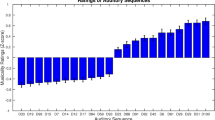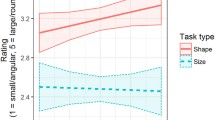Abstract
In developing a theoretical framework for the field of ecological acoustics, Gaver (1993b) distinguished between the experience of musical listening (perceiving sounds) and everyday listening (perceiving sources of sounds). Within the everyday listening experience, Gaver (1993a) proposed that the frequency of an object results from, and therefore specifies, the size of that object. The relation in which frequency and object size stand to one another is an example of a nomic mapping. A symbolic mapping involves the pairing of unrelated dimensions and, relative to a nomic mapping, requires an additional step in recognition and learning. Using a perceptual identification task, an experiment investigated the hypothesis that nomic mappings are identified more easily than symbolic mappings. It was predicted that the advantage manifests only during the everyday listening experience, and that the initially superior recognition of nomic mappings is equaled by symbolic mappings after extended exposure. The results provided support for the hypotheses. Theoretical implications of the differential recognition of nomic and symbolic mappings are discussed, together with practical applications of nomic relations.
Similar content being viewed by others
References
ASLIN, R. N., & SMITH, L. B. (1988). Perceptual development. Annual Review of Psychology, 39, 435–473.
BALLAS, J. A. (1993). Common factors in the identification of an assortment of brief everyday sounds. Journal of Experimental Psychology: Human Perception and Performance, 19(2), 250–267.
BALLAS, J. A., & HOWARD, J. R. (1987). Interpreting the language of environmental sounds. Environment and Behavior, 19(1), 91–114.
BARNARD, W. A., BREEDING, M., & CROSS, H. A. (1984). Object recognition as a function of stimulus characteristics. Bulletin of the Psychonomic Society, 22(1), 15–18.
BRAND, N., & JOLLES, J. (1985). Learning and retrieval rate of words presented auditorily and visually. The Journal of General Psychology, 112(2), 201–210.
CARELLO, C., ANDERSON, K. L., & KUNKLER-PECK, A. J. (1998). Perception of object length by sound. Psychological Science, 9, 211–214.
CHUTE, D. L., & WESTALL, R. F. (1996). Fifth generation research tools: Collaborative development with Powerlaboratory. Behavior Research Methods, Instruments, and Computers, 28, 311–314.
COOK, M. L. (1967). The power law as a special case of Fechner’s law. Perceptual & Motor Skills, 25(1), 51–52.
DEUTSCH, D. (Ed.). (1999). The psychology of music (2nd ed.). San Diego: Academic Press.
DOWLING, W. J. (1986). Context effects on melody recognition: Scale-step versus interval representations. Music Perception, 3, 281–296.
EDWORTHY, J., & STANTON, N. (1995). A user-centered approach to the design and evaluation of auditory warning signals: 1. Methodology. Ergonomics, 38(11), 2262–2280.
FAMILANT, M. E., & DETWEILER, M. C. (1993). Iconic reference: Evolving perspectives and an organizing framework. International Journal of Man-Machine Studies, 39, 705–728.
GARNER, W. R., & FELFOLDY, G. L (1970). Integrality of stimulus dimensions in various types of information processing. Cognitive Psychology, 1, 225–241.
GAVER, W. W. (1986). Auditory icons: Using sound in computer interfaces. Human-Computer Interaction, 2, 167–177.
GAVER, W. W. (1989). The SonicFinder: An interface that uses auditory icons. Human-Computer Interaction, 4, 67–94.
GAVER, W. W. (1993a). How do we hear in the world?: Explorations in ecological acoustics. Ecological Psychology, 5(4), 285–313.
GAVER, W. W. (1993b). What in the world do we hear?: An ecological approach to auditory event perception. Ecological Psychology, 5(1), 1–29.
GELDARD, F. A. (1962). Fundamentals of psychology. New York: Wiley.
GIBSON, J. J. (1979). The ecological approach to visual perception. Boston: Houghton Mifflin Company.
GREENE, R. (1988). Stimulus suffix effects in recognition memory. Memory & Cognition, 16(3), 206–209.
HEINE, W., & GUSKI, R. (1991). Listening: The perception of auditory events? Ecological Psychology, 3(3), 263–275.
HOWELL, D. C. (1997). Statistical methods for psychology (4th ed.). Belmont: Duxbury Press.
JACKO, J. A. (1996). The identifiability of auditory icons for use in educational software for children. Interacting With Computers, 8(2), 121–133.
JACKO, J. A., & ROSENTHAL, D. J. (1997). Age-related differences in the mapping of auditory icons to visual icons in computer interfaces for children. Perceptual and Motor Skills, 84, 1223–1233.
JENISON, R. L. (1997). On acoustic information for motion. Ecological Psychology, 9, 131–151.
JUSCZYK, P. W. (1997). The discovery of spoken language. Cambridge: Mit Press.
KELLER, P., & STEVENS, C. (2004). Meaning from environmental sounds: Types of signal-referent relations and their effect on recognizing auditory icons. Journal of Experimental Psychology: Applied, 10(1), in press.
LASS, N. J., EASTHAM, S. K., PARRISH, W. C., SCHERBICK, K. A., & RALPH, D. M. (1982). Listeners’ identification of environmental sounds. Perceptual and Motor Skills, 55, 75–78.
LEISER, R. G., AVONS, S. E., & CARR, D. J. (1989). Paralanguage and human-computer interaction. Part 2: comprehension of synthesized vocal segregates. Behaviour & Information Technology, 8(1), 23–32.
MELARA, R. D. (1989). Dimensional interaction between color and pitch. Journal of Experimental Psychology: Human Perception and Performance, 15(1), 69–79.
MELARA, R. D., & MARKS, L. E. (1990). Dimensional interactions in language processing: Investigating directions and levels of crosstalk. Journal of Experimental Psychology: Learning, Memory, and Cognition, 16(4), 539–554.
MICHAELS, C. E., & CARELLO, C. (1981). Direct perception. Englewood Cliffs, NJ: Prentice-Hall.
MICHELL, J. (1986). Measurement scales and statistics: A clash of paradigms. Psychological Bulletin, 100, 398–407.
MICHELL, J. (1990). An introduction to the logic of psychological measurement. Hillsdale, NJ: Erlbaum.
MICHELL, J. (1999). Measurement in psychology: Critical history of a methodological concept. Cambridge: Cambridge University Press.
MYNATT, E. D. (1997). Transforming graphical interfaces into auditory interfaces for blind users. Human-Computer Interaction, 12, 7–45.
PANSKY, A., & ZLGOM, D. (1999). Stroop and Garner effects in comparative judgement of numerals: The role of attention. Journal of Experimental Psychology: Human Perception and Performance, 25(1), 39–58.
RASCH, R., & PLOMP, R. (1999). The perception of musical tones. D Deutsch (Ed.). The psychology of music (2nd ed.) (pp. 89–112). San Diego: Academic Press.
ROSENBLUM, L. D., WUESTEFELD, A. P., & ZNDERSON, K. L. (1996). Auditory reachability: An affordance approach to the perception of sound source distance. Ecological Psychology, 8(1), 1–24.
SAVAGE, R., & GOUVIER, W. (1992). Rey auditory-verbal learning test: The effects of age and gender, and norms for delayed recall and story recognition trials. Archives of Clinical Neuropsychology, 7(5), 407–414.
SHAVELSON, R. J. (1988). Statistical reasoning for the behavioral sciences (2nd ed.). Boston: Allyn & Bacon.
STEVENS, K., & KELLER, P. (2003). Meaning from environmental sounds: Types of signal-referent relations and their effect on recognizing auditory icons. HFSP Workshop on Music and Language, Macquarie Centre for Cognitive Science, April, http://www.maccs.mq.edu.au/events/2003/hfsp2003/titles.htm
STOFFREGEN, T. A., & PITTENGER, J. B. (1995). Human echolocation as a basic form of perception and action. Ecological Psychology, 7(3), 181–216.
TABACHNICK, B. G., & FIDELL, L. S. (1996). Using multivariate statistics (3rd ed.). New York: Harper Collins.
VICENTE, K. J., & BURNS, C. M. (1996). Evidence for direct perception from cognition in the wild. Ecological Psychology, 8(3), 269–280.
WALKER, B. N., & EHRENSTEIN, A. (2000). Pitch and pitch change interact in auditory displays. Journal of Experimental Psychology: Applied, 6, 15–30.
WALKER, B. N., KRAMER, G., & LANE, D. M. (2000). Psychophysical scalings of sonification mappings. Paper presented at the International Conference on Auditory Display, Atlanta, USA, April. Retrieved September 19, 2000, from the World Wide Web: http:www.owlnet.rice.edu/≈walkerb/icad/icad2000/WalkerKramerLane.pdf
WARREN, W. H., & VERBRUGGE, R. R. (1984). Auditory perception of breaking and bouncing events: A case study in ecological acoustics. Journal of Experimental Psychology: Human Perception and Performance, 10(5), 704–712.
Author information
Authors and Affiliations
Corresponding author
Additional information
This research was conducted in the MARCS Auditory Laboratories and supported by a University of Western Sydney Summer Research Scholarship awarded to Sean Coward. The study benefited from discussions with members of MARCS. In particular, we thank Peter Keller and Michael Tyler for their contribution of ideas and technical assistance, and Denis Burnham for helpful comments on an earlier draft.
Rights and permissions
About this article
Cite this article
Coward, S.W., Stevens, C.J. Extracting Meaning from Sound: Nomic Mappings, Everyday Listening, and Perceiving Object Size from Frequency. Psychol Rec 54, 349–364 (2004). https://doi.org/10.1007/BF03395478
Published:
Issue Date:
DOI: https://doi.org/10.1007/BF03395478




